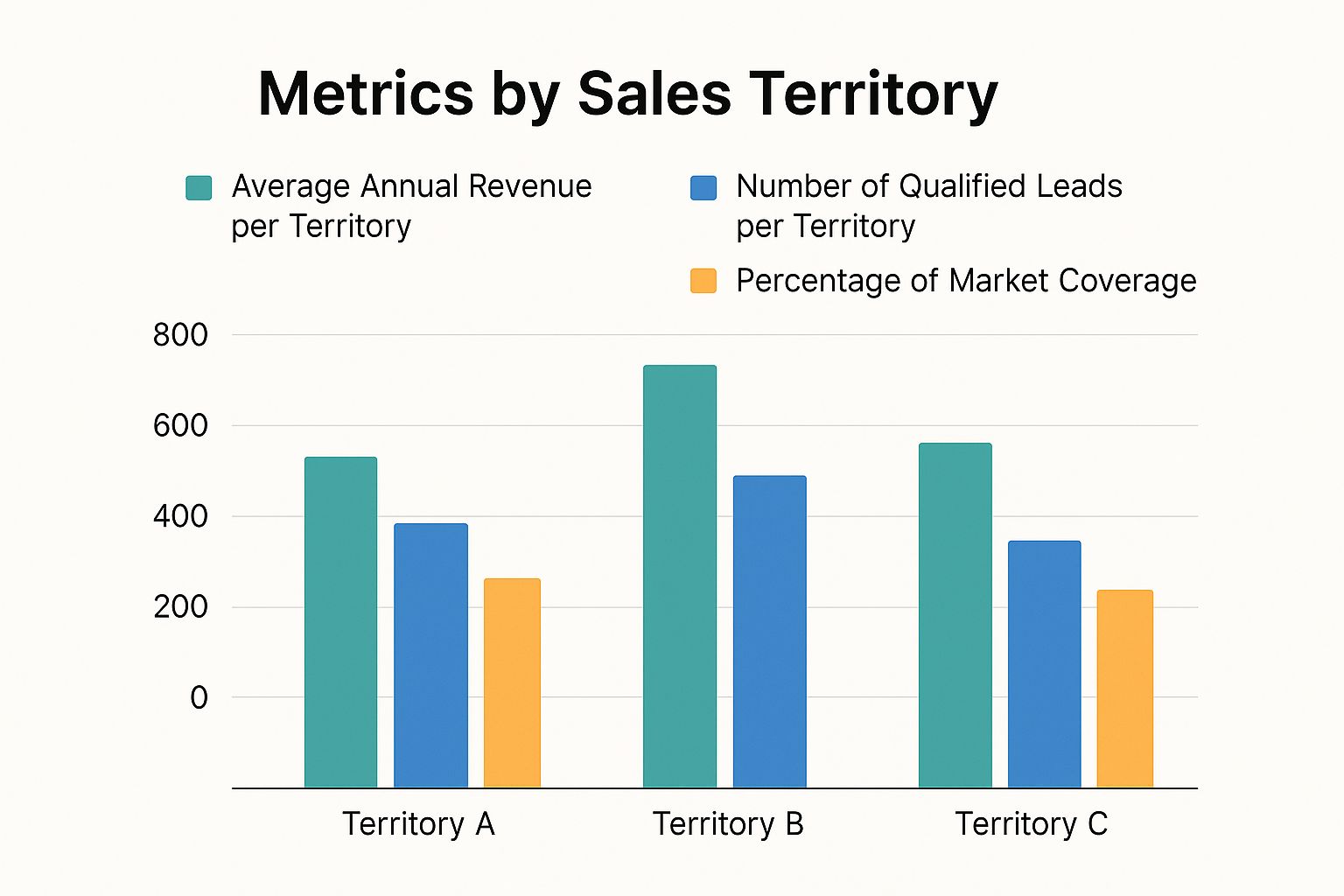A sales territory planning template is more than just a document—it’s a game plan. It's how you strategically organize your accounts, match them with the right reps, and lay out clear, achievable revenue goals. This turns a simple map into a powerful tool that balances workloads and uncovers growth opportunities you never knew you had.
Why Your Sales Map Is Holding You Back

That old sales map pinned to your office wall? It’s costing you a lot more than just pushpins. For so many sales leaders, the real problem isn't a lack of hustle from their team. It's the static, unbalanced territories that quietly sabotage motivation and leave a ton of revenue on the table.
A dynamic sales territory planning template isn't just a "nice-to-have" anymore; it's a critical tool for driving predictable growth.
Let's move past the textbook definitions and think about a real-world situation. Picture a software company where the top sales reps are constantly on the verge of burnout. They're drowning in high-value accounts scattered across a huge area. Meanwhile, the newer reps are struggling to even get close to their quota because they're stuck with sparse, low-potential leads.
What's the culprit? Poorly drawn lines on a map that were never designed around actual opportunity.
The Real Cost of Unbalanced Territories
This isn't just a simple organizational headache. It's something that directly hits your bottom line and crushes team morale. When territories are out of whack, you create an environment where success feels like luck, not something that was earned.
Here’s what really happens when you stick with a static approach:
- Top Performers Get Overwhelmed: Your best people are stretched way too thin. They can't give key accounts the focus they need, which puts you at risk of churn.
- Newer Reps Get Demotivated: You're setting up promising new talent for failure by handing them territories that don't have enough leads or real growth potential.
- Hidden Opportunities Are Completely Missed: You'll find pockets of high-value prospects that are being totally ignored simply because no one is assigned to strategically go after them.
The point of effective territory planning isn't just about carving up a map. It's about building a fair system where every single rep has a clear and realistic path to hitting their target.
This is why moving to a well-designed sales territory planning template is so important.
The data backs this up, too. Studies show that companies with a strategic approach to sales territory planning see, on average, 15% higher revenue and a 20% jump in sales productivity. Yet, despite these numbers, only about 39% of organizations manage to successfully use key data in their planning. You can dig deeper into these sales territory planning insights on Abacum.ai.
Gathering the Data That Actually Matters
Before you draw a single line on a map, you need the right intelligence. A great sales territory plan isn't built on a massive, messy data dump from your CRM. It’s built on clean, relevant information that actually helps you make smart decisions.
Think of it like this: you wouldn't just empty your entire pantry onto the counter to bake a cake. You’d pick the specific ingredients you need. It’s the same with territory planning—you need to be selective.
The Three Pillars of Territory Data
The most effective plans I've seen always pull from three key areas: your accounts, your reps, and the market itself. Getting these details right from the start is what makes a template truly work.
-
Account Data: Go deeper than just company names. You need to know their revenue history, realistic growth potential, industry, and the typical sales cycle length. This information tells you both the value of an account and the effort required to win it.
-
Rep Data: Your team isn't one-size-fits-all. Look at their past performance, their current workload, and where they really shine. Is someone a fantastic prospector while another is better at farming existing accounts? Where are they physically located? This is how you match the right person to the right opportunity.
-
Market Data: This gives you the context you can't get from internal numbers alone. How saturated is a particular area with competitors? How close are your target accounts to one another? A territory with 50 accounts packed into a single city is a world away from one with 50 accounts spread across an entire state.
This level of detail is non-negotiable for serious planning. Modern strategies rely on quantitative models to weigh factors like revenue potential, cost-to-serve, and location against how sales teams actually spend their time. You can discover more insights on territory design from Alexander Group.
Where to Dig Up This Information
Finding this data doesn’t have to feel like a treasure hunt. Most of it is already in the tools you use every day.
Start in your CRM. Create custom reports or views to filter your accounts by industry, last activity date, or annual recurring revenue (ARR). For tracking your team's performance, a solid sales performance metrics dashboard is your best friend. It can show you instantly who’s best at closing deals of a certain size or who dominates a particular vertical. We have a complete guide on how to build a sales performance metrics dashboard in our guide.
Your goal is not to collect all the data, but the right data. Clean, comprehensive information is what separates a template that looks good on paper from one that drives measurable results in the field.
With this raw material in hand, you're ready to build a template that creates fair, balanced territories. This upfront work is what stops the guesswork that so often leads to burned-out reps and missed quotas.
How to Build Your Sales Territory Template

The image above shows a simple but effective sales territory planning template. You can see how it gives a quick, high-level snapshot of who owns what and the financial targets tied to each area. For any sales leader, this kind of clarity is gold.
Now that you've got your data, it's time to roll up your sleeves and build a tool that actually works. Whether you're using a basic spreadsheet or a fancy platform, the mission is the same: turn all those raw numbers into a clear, actionable plan for your sales reps.
The first big decision you have to make is how you're going to carve up your market. There’s no single right answer here—the best model really depends on your product, your customers, and the way your team is set up.
Choosing Your Territory Model
The logic you use to segment your market is the foundation of your entire plan. Each approach comes with its own set of pros and cons, and requires a different kind of focus from your reps.
-
Geographic Territories: This is the old-school, classic approach—slicing up the map by zip code, state, or region. It's a no-brainer for field sales teams where travel time is a major factor. The big win here is efficiency. Reps can cluster their meetings and spend less time on the road and more time in front of customers.
-
Industry or Vertical Territories: Do you sell a highly specialized solution? Then assigning reps to specific industries like healthcare, finance, or manufacturing just makes sense. This lets them become true subject matter experts who can talk the talk and build instant credibility.
-
Account Tier Territories: This model is all about potential. You segment customers based on how much they could be worth. Your A-players might get a "Tier 1" territory filled with high-value enterprise accounts, while your up-and-comers tackle a "Tier 3" patch of smaller businesses with tons of growth potential.
I've found that the most successful territory plans often blend these models. You might have geographic territories that are then sub-divided by account tier. This gives you the best of both worlds: geographic efficiency and a sharp focus on your biggest opportunities.
At the end of the day, the right choice is the one that aligns your team's unique strengths with where the real money is in your market.
Structuring Your Template Framework
Once you’ve settled on a model, you can start building out the template itself. Honestly, a simple spreadsheet is a great place to begin. The most important thing is creating a single source of truth so every person on the team knows exactly what their responsibilities and goals are.
Here are the non-negotiable columns I'd recommend including:
- Territory Name: Give it a clear, obvious name (e.g., "Northeast – Enterprise," "West Coast – SMB," "Healthcare Vertical").
- Assigned Representative: Who owns it? Put their name right there to eliminate any confusion.
- Key Accounts: List the top 5-10 strategic accounts in that patch. This tells your reps where to focus their energy first.
- Total Addressable Market (TAM): An estimate of the total number of potential customers in the territory.
- Potential Revenue: What’s the total revenue opportunity? This is critical for balancing workloads fairly.
- Quarterly/Annual Quota: The specific sales target. No ambiguity.
- Activity Metrics (KPIs): Define the key activities you'll track, like new meetings booked, demos completed, or proposals sent.
This structure creates instant clarity and accountability. Every rep knows their patch, their number, and how you’re going to measure their success.
Build for Flexibility and Growth
One of the biggest mistakes I see is creating a plan that’s set in stone. Markets shift, people leave, and new opportunities pop up when you least expect them. A great sales territory planning template isn't a static document; it's a living, breathing tool.
Design it with the assumption that you’ll review and tweak it every quarter. Are some territories constantly falling short? Maybe the potential was off, or the rep needs more coaching. Is one rep crushing their quota by 150% every quarter? It might be time to split their territory to make sure you're not leaving money on the table.
This constant process of review and adjustment is what turns a decent plan into a powerful engine for predictable growth.
Balancing Territories for Fairness and Motivation
You can't just draw lines on a map and call it a day. The real work—and the real impact—comes from balancing those territories. If you get this wrong, you're setting yourself up for a demotivated team and, inevitably, missed revenue targets.
The whole point is to give every single rep a fair and genuine shot at hitting their number.
This means you have to look past the simple account count. True balance comes from digging into the real opportunity within each patch. You've got to weigh things like historical account value, legitimate growth potential, and even how clustered the leads are geographically.
Take a look at this chart. It's a perfect example of how territories can look balanced on paper but be wildly different in reality.

This visual shows a classic problem. One territory might be loaded with high-revenue accounts but get almost no new leads. That requires a very different sales motion than a territory packed with smaller, faster-moving prospects.
Getting Beyond Simple Geography
Let me walk you through a scenario I've seen play out dozens of times. A sales manager, let's call her Alex, sees one of her star reps, Sarah, consistently crushing it at 150% of her quota. Meanwhile, another solid rep, Ben, is barely scraping by at 70%. The knee-jerk reaction is to think it's a performance issue.
But Alex is smart. She pulls up their sales territory planning template and starts digging. What she finds is that Sarah’s territory is a goldmine—full of mature, high-spending accounts that practically run on autopilot. Ben, on the other hand, has a huge geographic area filled with smaller prospects, meaning most of his time is spent driving, not selling.
Ben isn't underperforming; he's underwater.
So, Alex rebalances. She shifts a couple of Sarah's stable, low-touch accounts over to Ben, giving him a foundation of predictable revenue. Then, she carves out a small, high-potential patch from another territory to give him more at-bats.
The result? Ben’s entire attitude changes. He hits 95% of his quota the very next quarter. And Sarah? With fewer distractions, she focuses on strategically growing her top accounts and boosts their spend by 15%. Fairness created a win for everyone.
Different Ways to Slice the Pie
There's no single "right" way to balance territories; it really depends on your business model, team structure, and goals. You might focus purely on geography, or you might segment by company size or industry.
Here's a quick comparison of some common models I've used and seen work well.
Territory Balancing Models Comparison
| Balancing Model | Best For | Key Metric | Potential Drawback |
|---|---|---|---|
| Geographic | Field sales teams, businesses with location-based services. | Number of accounts, travel time, zip codes. | Can create wide disparities in account potential. |
| Account-Based | Enterprise sales, targeting high-value "whale" accounts. | Named accounts, historical spend, company revenue. | Can be hard to scale and requires deep rep knowledge. |
| Vertical/Industry | Teams with specialized product knowledge. | Industry classification, market segment. | Reps may become too siloed; cross-sell opportunities missed. |
| Lead Volume | High-velocity sales models, inside sales teams. | Number of MQLs, conversion rate potential. | Ignores deal size, can lead to reps chasing small wins. |
Each model has its place. The key is to pick the one that aligns with your sales process and then layer in other metrics to fine-tune the balance.
Key Metrics for Keeping Things Fair
Balancing territories isn't a one-and-done project. You have to keep your eye on it. A good plan makes this easy by tracking the right KPIs. This is especially important for creating a fair system for both your inside and outside sales teams, since their day-to-day challenges are so different. We break this down further in our guide to the differences between inside and outside sales.
To make sure your territories stay optimized, keep a close watch on these areas:
- Quota Attainment Rate: Is success heavily concentrated in just a few territories? This is the most glaring red flag for an imbalance.
- Lead Distribution: Are your best leads getting spread around, or are a couple of reps getting all the good stuff?
- Sales Cycle Length: If one rep's territory has a much longer average sales cycle, they might need a lower quota or a different account mix to have a fair shot.
- Workload vs. Windshield Time: For field reps, how much time is actually spent selling versus driving? High travel time is a killer and a hidden workload factor that burns people out.
Ultimately, companies that get this right see massive returns. A well-optimized territory plan can drive a 10% to 20% increase in sales productivity just by getting the right reps in front of the right opportunities. Balanced territories are the foundation for a motivated, high-performing sales team.
Bringing Your New Territory Plan to Life
You've built a brilliant sales territory plan. Great. But if it just sits in a spreadsheet on a shared drive, it's worthless. The real magic happens when you turn that plan into a living, breathing strategy that your team actually uses. Rolling it out isn’t just about sending an email with new assignments; it’s about getting your team invested, communicating clearly, and setting up a system for continuous improvement.
Think of the initial rollout as your big launch. You have to sell it to your team. Don't frame it as a top-down order. Instead, present it as a strategic shift designed to open up more opportunities for everyone. Be transparent. Walk them through the "why" behind the new map—explain how it evens out the workload, taps into market potential, and gives every rep a legitimate shot at crushing their number.
Expect some pushback and a lot of questions. That’s totally normal. The key is to show them this isn't just a random reshuffling of accounts. It's a decision backed by data, designed to help the whole team win.

Your Rollout Checklist
To make the transition as smooth as possible, you need a clear, actionable checklist. This eliminates confusion and gives everyone a roadmap to follow.
- Host a Team Kick-Off Meeting: Don't just send an email. Get everyone together, walk through the new territory assignments, explain the data behind the decisions, and set clear expectations from day one.
- Create Individual Handover Docs: Give each rep a simple one-pager. It should summarize their new patch, list their key accounts, state their quota, and outline the specific KPIs they'll be measured on.
- Update Your CRM Instantly: This is non-negotiable. The new territories have to be live in your CRM before the launch. The last thing you need is chaos with lead routing or account ownership disputes.
- Schedule 1-on-1 Follow-Ups: In the first week, sit down with each rep individually. This is their chance to ask the questions they didn't want to ask in a group setting and for you to make sure they have a solid plan of attack.
The whole point of the rollout is to minimize disruption and build momentum. A well-planned launch can turn a potentially bumpy transition into a starting gun that gets everyone fired up for the next quarter.
From Static Plan to Living Strategy
The single biggest mistake I see leaders make is treating their territory plan as a "set it and forget it" project. Markets change, competitors get aggressive, and your own team's skills evolve. Your plan has to be able to adapt.
This is where a simple, consistent review process becomes your secret weapon.
Put a recurring meeting on the calendar—a quarterly review is a great place to start. The goal isn't to redraw the entire map every three months. It's about making small, intelligent tweaks based on what's actually happening on the ground. For larger teams, looking at how to automate the sales process can help pull performance data together much faster.
During these check-ins, you should be asking some tough questions:
- Which territories are killing it, and which are lagging? Is it a coaching issue with the rep, or is the territory itself fundamentally unbalanced?
- Has our ideal customer changed? Maybe a new product feature has opened up a whole new industry we hadn't considered.
- What are the reps telling us? Your team is on the front lines. They often see market shifts and hear competitor buzz long before it ever shows up in a report.
This ongoing feedback loop is what transforms your sales territory planning template from a document into a dynamic tool for growth. It keeps your team aimed at the best opportunities, all the time.
Common Questions About Sales Territory Planning
Even the most buttoned-up territory plan is going to spark a few questions. That’s a good thing. When you're making big changes to how your sales team operates, you want people to be engaged and thinking critically.
Let's tackle some of the most common questions sales leaders ask. Getting these right can be the difference between a smooth rollout and a rocky start.
How Often Should I Revisit My Sales Territories?
The big, top-to-bottom review? That's an annual thing. But you can't just set it and forget it for 12 months. The market moves way too fast for that.
I always recommend lighter quarterly check-ins. These are your chances to make small, data-backed tweaks. Maybe one rep is drowning while another is coasting—a quarterly review lets you rebalance things before it becomes a real problem.
Of course, some events demand an immediate look at your territories, no matter where you are in the cycle. These triggers include:
- Major Market Shifts: A new competitor just popped up, or a regulatory change just shook up your industry.
- New Product Launches: You've just released a new product line that appeals to a completely different type of customer.
- Significant Team Changes: You've hired a new batch of reps or a seasoned pro just left, leaving a critical territory wide open.
- Consistent Underperformance: A couple of territories are always missing their numbers. This is a huge red flag that something is fundamentally unbalanced.
Think of your sales territory plan as a living document, not a stone tablet. Regular adjustments are a sign of a healthy, responsive sales organization.
What Are the Biggest Mistakes People Make in Territory Planning?
It’s surprisingly easy to get territory planning wrong, and most of the time, it comes down to a few classic blunders. The single biggest mistake I see is focusing solely on geography. Drawing neat lines on a map means nothing if you ignore the actual potential within those lines.
Here are a few other pitfalls to watch out for:
- Creating Unbalanced Territories: Nothing crushes morale faster than giving one rep a goldmine and another a barren wasteland. True fairness is about equal opportunity, not just an equal number of accounts.
- Not Involving the Sales Reps: If you hand down a new plan from an ivory tower, don't be surprised when your team doesn't embrace it. Your reps are on the front lines; their ground-level insights are pure gold.
- Relying on Messy CRM Data: Garbage in, garbage out. A territory plan built on outdated or incomplete data is destined to fail before it even starts. Clean data is non-negotiable.
- Treating It as a One-And-Done Task: Your market, your customers, and your team are constantly evolving. A plan that isn’t regularly reviewed and updated will become irrelevant in a hurry.
What Are the Best Tools for This Job?
Honestly, a well-built spreadsheet is a perfectly good place to start, especially for smaller teams. But as you grow, you'll quickly hit its limits. That's when you should look into dedicated software.
The game-changer is finding a tool that pulls data directly from your CRM in real time. Look for platforms that offer true sales territory mapping and visualization. Tools like Salesforce Maps or Zoho CRM have these features built-in.
There are also more specialized options like eSpatial or TerrAlign that offer really advanced features—think automated territory balancing and AI-powered route optimization. These tools can transform your static template into a dynamic, strategic command center for your entire sales force.
